初中英语北师大版教材1
- 格式:pdf
- 大小:211.39 KB
- 文档页数:8
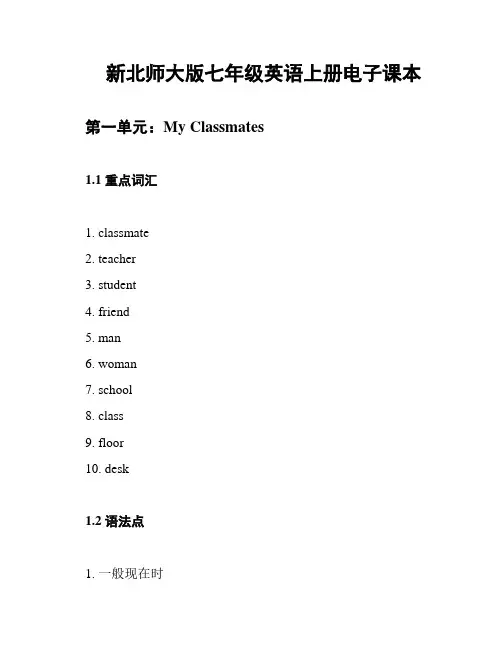
新北师大版七年级英语上册电子课本第一单元:My Classmates1.1 重点词汇1. classmate2. teacher3. student4. friend5. man6. woman7. school8. class9. floor10. desk1.2 语法点1. 一般现在时2. 名词所有格1.3 功能句型1. What's your name?2. My name is...3. What class are you in?4. I'm in Class...5. What does your mother do?6. She's a...第二单元:My Family 2.1 重点词汇1. family2. father3. mother4. brother5. sister6. son7. daughter8. grandma9. grandpa10. uncle2.2 语法点1. 一般现在时2. 家庭成员的介绍2.3 功能句型1. This is my...2. She's a...3. He's a...4. They are...第三单元:My School3.1 重点词汇1. school2. subject3. teacher4. student5. class6. library7. laboratory8. playground9. basketball10. football 3.2 语法点1. 一般现在时2. 名词所有格3.3 功能句型1. What subject do you like?2. I like...3. What time does your class start?4. It starts at...第四单元:My Hobbies4.1 重点词汇1. hobby2. read3. write4. swim5. play6. listen7. music8. watch9. movie10. sports4.2 语法点1. 一般现在时2. 动词短语4.3 功能句型1. What's your hobby?2. I like...3. Do you like...?4. Yes, I do. No, I don't.第五单元:Food and drinks 5.1 重点词汇1. food2. drink3. meat4. fish5. vegetable6. fruit7. rice8. bread9. milk10. water5.2 语法点1. 一般现在时2. 食物和饮料的名称5.3 功能句型1. What do you like to eat/drink?2. I like...3. Do you like...?4. Yes, I do. No, I don't.第六单元:Healthy Lifestyle6.1 重点词汇1. healthy2. lifestyle3. exercise4. sleep5. diet6. smoke7. drink8. coffee9. tea10. sugar6.2 语法点1. 一般现在时2. 形容词和副词6.3 功能句型1. What's a healthy lifestyle?2. A healthy lifestyle includes...3. Do you have a healthy lifestyle?4. Yes, I do. No, I don't.第七单元:Animals7.1 重点词汇1. animal2. cat3. dog4. fish5. bird6. elephant7. tiger8. lion9. bear10. panda7.2 语法点1. 一般现在时2. 动物的名称7.3 功能句型1. What's this animal?2. It's a...3. Do you like this animal?4. Yes, I do. No, I don't. 第八单元:Seasons 8.1 重点词汇1. season2. spring3. summer4. autumn5. winter6. hot7. cold8. warm9. cool10. sunny8.2 语法点1. 一般现在时2. 季节的名称和描述8.3 功能句型1. What season is it?2. It's...3. Do you like this season?4. Yes, I do. No, I don't.参考答案请参考课本末尾的参考答案部分,以获取本册英语电子课本的练题和测试题的答案。

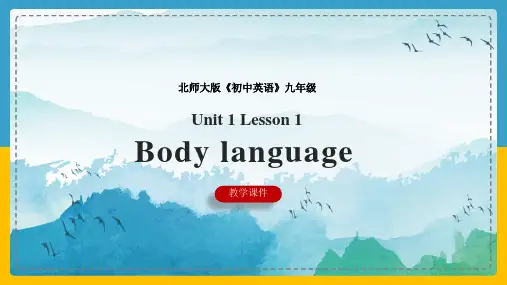
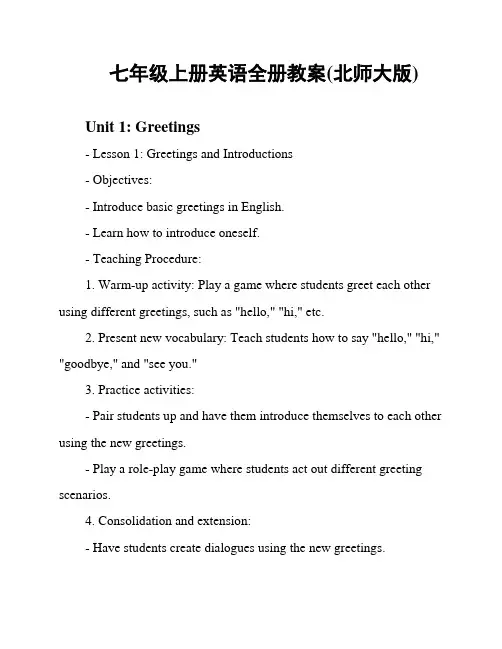
七年级上册英语全册教案(北师大版)Unit 1: Greetings- Lesson 1: Greetings and Introductions- Objectives:- Introduce basic greetings in English.- Learn how to introduce oneself.- Teaching Procedure:1. Warm-up activity: Play a game where students greet each other using different greetings, such as "hello," "hi," etc.2. Present new vocabulary: Teach students how to say "hello," "hi," "goodbye," and "see you."3. Practice activities:- Pair students up and have them introduce themselves to each other using the new greetings.- Play a role-play game where students act out different greeting scenarios.4. Consolidation and extension:- Have students create dialogues using the new greetings.- Ask students to write a short paragraph introducing themselves to the class.5. Review and assessment:- Conduct a class discussion on the importance of greetings in different cultures.- Assess students' understanding through a written quiz.- Lesson 2: Polite Expressions- Objectives:- Learn useful polite expressions in English.- Practice using polite language in various situations.- Teaching Procedure:1. Warm-up activity: Show pictures of different scenarios and ask students to choose the most appropriate polite expression for each situation.2. Present new vocabulary: Teach students expressions such as "excuse me," "thank you," "please," and "sorry."3. Practice activities:- Role-play different situations where students use the newly learned expressions.- Have students create dialogues using the polite expressions.4. Consolidation and extension:- Ask students to write a short paragraph describing a situation where they used polite expressions.- Conduct a class activity where students practice polite expressions in different scenarios.5. Review and assessment:Unit 2: Family- Lesson 1: Talking about Family- Objectives:- Learn vocabulary related to family members.- Practice using possessive pronouns to describe family relationships.- Teaching Procedure:1. Warm-up activity: Play a memory game where students match family member vocabulary cards.2. Present new vocabulary: Introduce family member vocabulary words such as "father," "mother," "brother," etc.3. Practice activities:- Have students create a family tree using the vocabulary words.- Practice using possessive pronouns to describe their family members.4. Consolidation and extension:- Pair students up and have them interview each other about their families.- Ask students to write a short paragraph describing their family using possessive pronouns.5. Review and assessment:- Conduct a class discussion on the importance of family and the roles of different family members.- Assess students' understanding through a group activity where they present their family trees.- Lesson 2: Describing Family- Objectives:- Learn how to describe family members using physical appearance and personality traits.- Practice using adjectives to describe people.- Teaching Procedure:1. Warm-up activity: Show pictures of different family members and ask students to describe them using adjectives.2. Present new vocabulary: Introduce adjectives related to physical appearance and personality traits.3. Practice activities:- Have students describe their own family members using the new vocabulary.- Play a guessing game where students describe a family member and others guess who it is.4. Consolidation and extension:- Ask students to create a poster describing their favorite family member using adjectives.- Conduct a class activity where students present their posters and describe their family members.5. Review and assessment:- Assess students' understanding through a class discussion on the importance of understanding and appreciating family members.- Assign a written task where students describe their favorite family member using adjectives....(Note: This document is a sample teaching plan for Grade 7 English textbook published by Beijing Normal University Press. The actual teaching plan may vary based on specific teaching requirements and classroom dynamics.)。
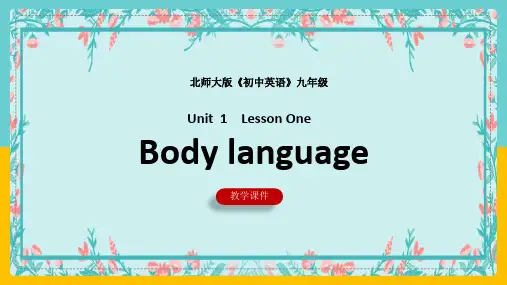
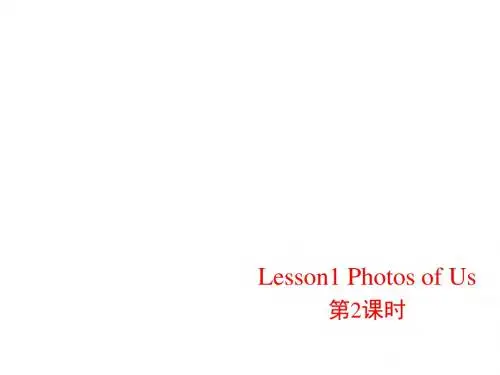
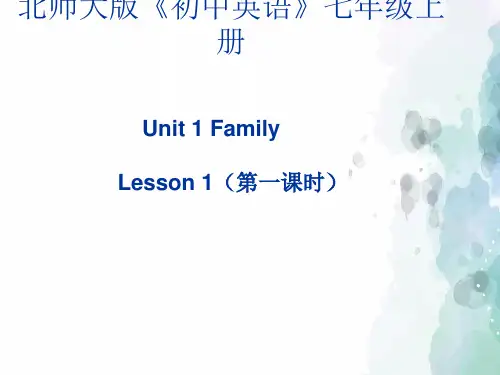
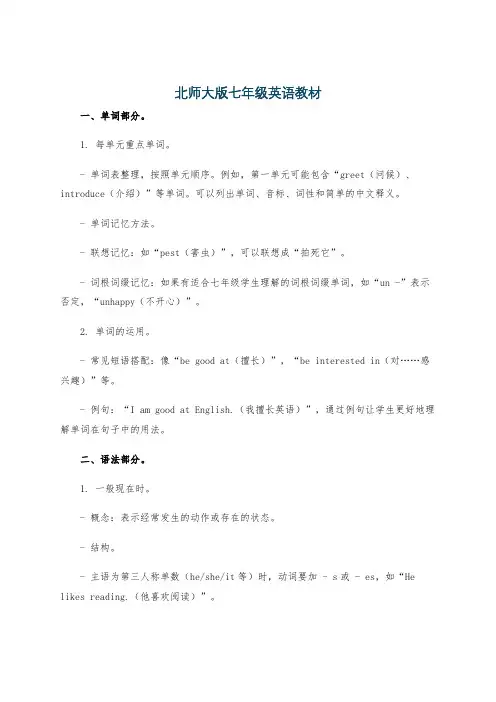
北师大版七年级英语教材一、单词部分。
1. 每单元重点单词。
- 单词表整理,按照单元顺序。
例如,第一单元可能包含“greet(问候)、introduce(介绍)”等单词。
可以列出单词、音标、词性和简单的中文释义。
- 单词记忆方法。
- 联想记忆:如“pest(害虫)”,可以联想成“拍死它”。
- 词根词缀记忆:如果有适合七年级学生理解的词根词缀单词,如“un -”表示否定,“unhappy(不开心)”。
2. 单词的运用。
- 常见短语搭配:像“be good at(擅长)”,“be interested in(对……感兴趣)”等。
- 例句:“I am good at English.(我擅长英语)”,通过例句让学生更好地理解单词在句子中的用法。
二、语法部分。
1. 一般现在时。
- 概念:表示经常发生的动作或存在的状态。
- 结构。
- 主语为第三人称单数(he/she/it等)时,动词要加 - s或 - es,如“He likes reading.(他喜欢阅读)”。
- 主语为其他人称时,动词用原形,如“I play football every day.(我每天踢足球)”。
- 时间标志词:“always(总是)、usually(通常)、often(经常)、sometimes(有时)、never(从不)”等。
2. 形容词性物主代词。
- 形式:“my(我的)、your(你的/你们的)、his(他的)、her(她的)、its(它的)、our(我们的)、their(他们的)”。
- 用法:后面必须接名词,如“My book is on the desk.(我的书在桌子上)”。
三、课文部分。
1. 课文主题概括。
- 每个单元的课文有不同的主题,如家庭、学校生活等。
对课文主题进行简单概括,让学生更好地理解课文的主旨。
2. 重点句子解析。
- 从课文中选取一些有代表性的句子进行详细解析。
例如,“It's important for us to learn English well.(对我们来说学好英语是很重要的)”,分析句子结构,“it”作形式主语,真正的主语是“to learn English well”。
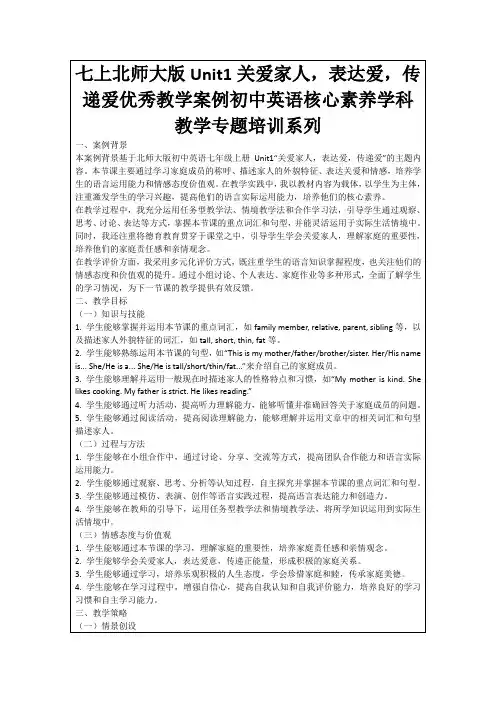
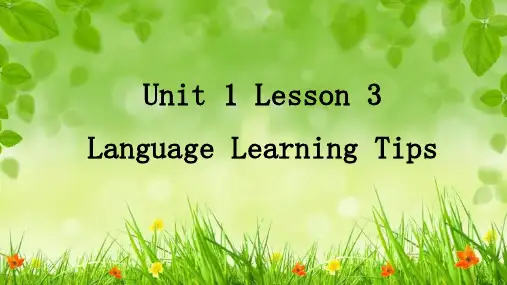

北师大版七年级上册英语全册教案第一单元:打招呼本单元主要通过教授基本的日常问候用语,帮助学生学会如何与人友好地交流。
课时1:你好!教学目标:- 研究基本问候用语,如“Hello”,“Goodmorning/afternoon/evening”,“How are you?”等。
- 能够用英语和人友好地打招呼,并正确回应问候。
教学内容:1. 听录音,模仿语音并跟读基本问候用语。
2. 练和同桌进行简单的交流,用英语进行问候。
教学重点:- 学会正确的语音和语调,让问候更加自然。
- 熟练运用问候用语进行简单对话。
教学准备:- 录音机、教材、黑板、笔等。
教学过程:1. 听录音,跟读基本问候用语。
2. 学生进行两两配对练,用英语互相问候并回答。
3. 部分学生上台展示对话。
4. 教师和学生一起总结本节课学到的问候用语。
课时2:早上好!教学目标:- 研究如何用英语打招呼并询问对方的身体状况,如“How are you?”。
- 研究回答身体状况,并用英语表达谢意。
教学内容:1. 听录音,模仿语音并跟读问候用语。
2. 听录音,研究回答问候和询问身体状况的用语。
3. 练和同桌进行简单对话,运用所学问候用语。
教学重点:- 学会正确运用“How are you?”的用法和回答身体状况的表达。
- 熟练运用问候用语进行简单对话。
教学准备:- 录音机、教材、黑板、笔等。
教学过程:1. 听录音,跟读问候用语。
2. 听录音,研究回答身体状况的用语。
3. 学生进行两两配对练,用英语互相问候并回答。
4. 教师和学生一起总结本节课学到的问候用语。
课时3:下午好!教学目标:- 研究如何用英语打招呼并询问对方的活动情况,如“What's up?”。
- 研究回答对方的活动情况,并用英语表达谢意。
教学内容:1. 听录音,模仿语音并跟读问候用语。
2. 听录音,研究回答问候和询问活动情况的用语。
3. 练和同桌进行简单对话,运用所学问候用语。
教学重点:- 学会正确运用“What's up?”的用法和回答活动情况的表达。
北师大英语初中教材初一教材编排知乎北师大英语初中教材的初一教材编排如下:1. Unit 1: Greetings and Introductions- Lesson 1: Greetings- Lesson 2: Self-introduction- Lesson 3: Asking for and giving personal information2. Unit 2: My School Life- Lesson 1: School subjects and schedules- Lesson 2: School facilities and rules- Lesson 3: Extracurricular activities3. Unit 3: My Family and Friends- Lesson 1: Family members and relationships- Lesson 2: Talking about family routines and activities- Lesson 3: Describing friends and talking about hobbies and interests4. Unit 4: Daily Routines- Lesson 1: Telling time and daily routines- Lesson 2: Describing daily activities and the sequence of events - Lesson 3: Talking about weekend activities and plans5. Unit 5: Food and Drinks- Lesson 1: Food and drinks vocabulary- Lesson 2: Talking about personal food preferences and dietary habits- Lesson 3: Ordering food and drinks in a restaurant6. Unit 6: Places in my City- Lesson 1: Describing places in the city- Lesson 2: Giving directions and asking for locations- Lesson 3: Talking about attractions and activities in the city 7. Unit 7: Daily Weather- Lesson 1: Describing weather conditions and clothing- Lesson 2: Talking about seasonal weather patterns and activities- Lesson 3: Describing past and future weather conditions8. Unit 8: Hobbies and Sports- Lesson 1: Talking about hobbies and interests- Lesson 2: Describing sports and playing techniques- Lesson 3: Talking about sports events and competitions9. Unit 9: Transportation and Travel- Lesson 1: Talking about means of transportation- Lesson 2: Describing travel experiences and vacation plans- Lesson 3: Giving and asking for travel recommendations10. Unit 10: Holidays and Festivals- Lesson 1: Talking about holidays and festivals- Lesson 2: Describing traditional customs and celebrations- Lesson 3: Talking about holiday plans and activities请注意,这只是一个草稿,具体编排可能会根据教材的版本和出版社的要求有所不同。